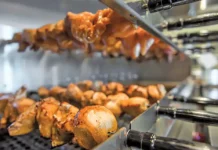
Article contributed by Joy Pouros, Culinary Software Services
Hotel restaurants and foodservice are under pressure to remain competitive in an ever-changing landscape. Running a successful operation requires a delicate balance of constant ingenuity and a pragmatic mindset.
What separates a fad and a lasting trend? It can be devastating to invest time and resources in securing new suppliers, training staff, and making significant menu or operational changes only for a trend to go out of style as fast as it came in. It’s a huge opportunity when a trend also happens to make business sense. We’ve taken a look at hospitality and foodservice trends from this year and identified several that are here to stay that will also have a positive impact on your business’ bottom line.
Reducing Food Waste
Between poor storage practices, lapses in supply chains, and prep and consumer waste, much of the food purchased by restaurant goes into landfills. That is why we love this trend – while there are several non-financial reasons to reduce food waste, it’s also cost effective for restaurants and hotels and a good business decision. In a study of over 700 businesses, every $1 invested in food waste reduction led to a median $14 in cost savings.
There are several ways to go about reducing food waste. Diving into your supply chain, food storage practices, and other operational procedures can quantify exactly how much food is going to waste and help you identify areas where you have the most to gain, and thus where to focus your efforts and investments. Once you have identified what is going to waste, developing menu items that use more of what you are already buying, and therefore reducing how much you are throwing away, not only help to reduce food waste but can also potentially monetize more of your inventory. Finally, set a plan in place for what cannot be used or prevented: for example, composting leftover produce.
In addition to financial objectives, reducing food waste elevates your standing in the community, with your stakeholders, and with informed and engaged consumers. Food waste contributes to overflowing landfills, greenhouse gas emissions, water and land consumption, and pesticide use. And while it is the right thing to do regardless of who knows about it, communicating your efforts can attract more customers.
Increasing Ingredient Transparency
Menus have gotten a little more complicated than they once were. People want to know what to expect, and while that desire used to be assuaged with a general description of the dish, now customers want to know where the food was sourced and additional information about ingredients that will be used.
Some of that push comes from the recent influx in consumers striving to eat ethically. However, this is defined differently for individuals. This can include organic, vegetarian, vegan, locally sourced, non-GMO, sustainably sourced, and many other considerations. It’s impractical for most to adhere to every ingredient concern, but it’s important to customers to understand which dishes do comply with any of these qualifiers.
While it’s trendy for some, it has life altering consequences for others. Food allergies, including life threatening ones, are on the rise. Restaurants should heavily consider adding allergen notices on their menus. In particular, most major food allergen reactions are caused by just eight food items: milk, eggs, peanuts, tree nuts, wheat, soy, fish and crustacean shellfish. This isn’t even taking into account food sensitivities or intolerances, which are also on the rise – the most common being gluten and lactose. Properly labeling dishes isn’t about being trendy; it’s a matter of public safety.
Labeling is only one part of the equation; ensure the kitchen is utilizing best practices when it comes to preventing cross contamination. Some people think of raw meat when they hear “cross contamination” but the reality could be as simple as a breadcrumb. Ingredient transparency keeps your customers safe, while also appealing to customers who want or need the transparency.
Expanding Technology
Technology isn’t just for Millennials – 77% of Americans over 50 use a smartphone. Go beyond free WiFi and leverage the technology available to boost guests’ experience. Allow guests to log in via an app and order food or drink service in advance. Imagine busy people on business trips being able to order dinner while in a taxi on the way back to their hotel and having it ready when they arrive. And imagine being able to see what they’ve ordered in the past and sending them a notification asking if they’d like another martini when they return to their room tonight. A great experience for them, good business for you. Investing in new technology can have an impact on a hotel’s bottom line beyond foodservice, by streamlining the check in and check out processes, upselling services, and controlling utility costs when those options are available using apps. A robust and well-implemented app can combine overall operational and sales goals for the hotel with foodservice opportunities and achieve high guest satisfaction.
When upgrading, the user experience should be top priority. Baby Boomers can find technology frustrating, but only if it’s difficult to figure out. When technology is intuitive, guests of all generations can enjoy. Don’t underestimate the older generations’ use of technology – more than 15% of time spent online by Baby Boomers is on Facebook.
Speaking of social media, we’d be remiss if we didn’t address the ever-present platforms. Once, word of mouth was limited to the handful of people a guest spoke with when they returned home, or perhaps even later when a friend asked about their experience. Those days are long gone, and now guests are pushing out their impressions and feedback in real time to hundreds of people on social media. Use that to your advantage by having Instagram-worthy décor. Monitor public posts and even share posts (with guests’ permission) showing guests having a great time. Encourage guests to sit and enjoy a little while longer with charging stations readily available.
Combine Traditional Venues with Nontraditional Offerings
Food and drink are entwined in culture, and American culture places a big emphasis on convenience. Think of all the things guests can do at a hotel and their home equivalent. Place fresh or protein-rich snacks and appropriate drinks near the fitness center. Have a bar near the lobby so guests can get a drink as soon as they walk in. Or some prepared foods available in the lobby for guests to grab quickly as they leave hurriedly for their conference or on their way to the airport.
Hotel convenience areas don’t have to be boring – offer prepared foods, designer cocktails, and lattes in addition to the standard candy bars, mini bottles of wine, and brewed coffee. Elevate the guest experience by providing high end choices regardless of where they are in the hotel or what time it is.
American palates have gotten increasingly global, but ethnic cuisine is most often associated with lunch and dinner. Branch out and offer breakfast menus with flavors from around the world. More than 80% of Americans eat ethnic cuisines regularly, and it doesn’t require a complete overhaul of ingredients. Many globally-influenced dishes can be achieved by swapping out a few ingredients in a dish that is already on a menu, i.e. chorizo for sausage. There’s no need to wait for dinner for spices like curry or sumac! From a highly Americanized but fun “breakfast sushi” to authentic dishes like shakshuka, making the morning a fun and interesting experience makes a lasting impression on guests.
Common Interests
Many will point out that the industry continues to be steered by the Millennial generation. While Millennials may be making their desires heard and are early adopters of new practices, it’s important to note that the older generations are absolutely benefitting from and enjoying the same trends. Where eating healthy is trending for young adults, it’s a matter of doctor’s orders for Baby Boomers. Convenience and social experiences are appreciated by guests of all ages. Aside from their broad appeal among guests, these trends have other benefits to offer, from lowering operational costs to increasing guest safety. The end result? These trends contribute to your bottom line, and positive ROI never goes out of style.
Joy Pouros works as the authority writer in the Training department at Culinary Software Services, where she writes on topics as diverse as human resource issues to increasing profits. Joy entered the industry working as a Nutritional Aide in the Chicagoland area before moving into writing and consulting. Joy now specializes in marketing and public relations and writes for a variety of industries.
























Comments are closed.